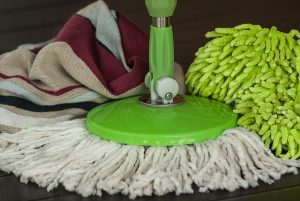Cleaning is the Worldwide Home Improvement
CLEANING is the worldwide home improvement. It maintains the client’s home in such a way as to display it’s beauty, prolong the life of the surfaces and finishes, and if done well can delay the need for repainting or costly home improvements. Cleaning ranges from washing windows to scrubbing mildew from bathroom walls, and from cleaning ovens to dusting skirting boards. In performing these tasks you will need to call upon a vast range of cleaning tools, from the simple sponge and mop to the sophisticated buffing and polishing machine.
The need for so many varied cleaning supplies is a direct result of the diversity of materials and surfaces encountered in the many homes that you will work in. In the course of cleaning an average home, while moving from room to room you may deal with up to thirty or more different surfaces. In the kitchen, for example, are plastic laminate or granite worktops, a stainless steel sink, porcelain enamel or halogen appliances, vinyl or cork tiles, and stained or painted wooden cabinets. The living room represents another set of challenges: Carpeting or polished wooden floors, textured upholstery, furniture made of wood, glass, metal or plastic. In older style homes the study may have wood-paneled walls, an acoustic tile ceiling, and a brick fireplace surrounded by flat slabs of stone to make a hearth. On to the bedrooms where you (as the person performing the cleaning) may need to cope with patterned or textured paint on the walls, glass mirrors, and bed-heads or four-poster frames made of materials as different as lacquered brass and painted wicker. Then, finally, to the bathroom, with it’s ceramic tile floor, porcelain sink and toilet, porcelain or fiberglass bath or spa bath, and gold plated taps and fittings.
While general-purpose detergents and household cleaners take care of many of these tasks, each surface being cleaned responds best to a particular combination of cleaning agent, technique and tools. The combination, furthermore, is subject to change; it is affected by the type of stain or dirt, and even by the place in which the surface is located. Thus an interior ceramic floor tile is vacuumed, washed down with a mild detergent, and finished with a mixture of hot water and mentholated spirits to rinse off any remaining residue, whereas an exterior ceramic veranda tile would need to be swept first, followed by possible scrubbing with a scrubbing brush to remove built-up dirt, before hosing down. Similarly, window glass is cleaned in one way, but a different method applies to the prisms that dangle from a chandelier.
For any surface that you attempt to clean – wooden floors; wooden furniture; interior stonework; metals; plastics; glass; porcelain, enameled or gold plated taps and fittings; and wallpaper – there is one general rule. Always begin with the least abrasive or caustic cleaning agent, and move up to a stronger one only when the mild one fails to do the job. Gentle cleaning prolongs the life of the finish on most household surfaces, eliminating the need to restore a finish harmed by too rigorous or too caustic a clean, to which you may find yourself liable to replace as the hired help.
